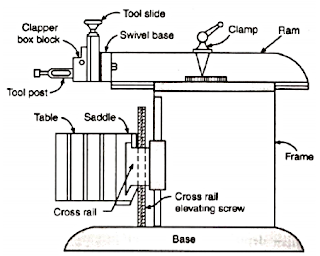The shaper is a machine tool
used primarily for:
- Producing
a flat or plane surface which may be in a horizontal, a vertical or an angular
plane.
- Making
slots, grooves and keyways
- Producing contour of concave/convex or a combination of these.
Working Principle
The job is rigidly fixed on
the machine table. The single point cutting tool held properly in the tool post
is mounted on a reciprocating ram. The reciprocating motion of the ram is
obtained by a quick return motion mechanism. As the ram reciprocates, the tool
cuts the material during its forward stroke. During return, there is no cutting
action and this stroke is called the idle stroke. The forward and return
strokes constitute one operating cycle of the shaper.
Construction
The main parts of the Shaper
machine is Base, Body (Pillar, Frame, Column), Cross rail, Ram and tool head
(Tool Post, Tool Slide, Clamper Box Block)
Base: The
base is a heavy cast iron casting which is fixed to the shop floor. It supports
the body frame and the entire load of the machine. The base absorbs and
withstands vibrations and other forces which are likely to be induced during
the shaping operations. Body (Pillar, Frame, Column): It is mounted on the base
and houses the drive mechanism compressing the main drives, the gear box and
the quick return mechanism for the ram movement. The top of the body provides
guide ways for the ram and its front provides the guide ways for the cross
rail.
Cross
rail: The cross rail is mounted on the front of the body frame
and can be moved up and down. The vertical movement of the cross rail permits
jobs of different heights to be accommodated below the tool. Sliding along the
cross rail is a saddle which carries the work table.
Ram
and tool head: The ram is driven back and forth in its
slides by the slotted link mechanism. The back and forth movement of ram is
called stroke and it can be adjusted according to the length of the workpiece
to be-machined.








